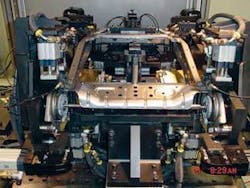Owning the process
Johnson Controls gained ownership of the remote beam laser welding process through the use of DOEs, regression statistical models, and laser beam and weld quality monitoring
Carl Klein, Mark Williamson, and Anthony Kestian
In 1995 Johnson Controls Inc. (JCI) began working with technical centers, including the Fraunhofer and EWI, to better identify production opportunities made available by laser welding technology. The following year we began to investigate laser welding using a robot-mounted Nd:YAG laser system at our Corporate Research Center in Milwaukee. Research in 1998 included remote beam laser welding process development supported by our Athens, TN, plant and the University of Tennessee Space Research Center (Tullahoma, TN). This activity focused on directly replacing MIG and spot welding. The production use of remote beam CO2 laser welding at our Lahnwerk, Germany, facility was started in 2002, and that facility currently has two 2.5kW, remote beam CO2 laser systems in the production of rear seat components for VW and GM-Opel. In 2003, the company developed a front seat structure capable of being manufactured using GMAW, spot weld, and laser welding processes so the product can be manufactured globally using regionally available weld technologies.
The building blocks to do remote beam laser welding consist of a high beam quality laser and a remote scanning mirror welding head with a long focal length to allow the distance between the beam manipulating element and the weld target to be as large as possible (often 1 to 2 meters). The scanning mirrors (see Figure 1) reflect the beam to the workpiece and generate a highly dynamic laser spot and or stitch laser weld. This remote beam laser welding process has numerous advantages: high welding speeds with virtually no indexing time, high geometric flexibility, and very precise positioning all in a small footprint system.
This approach to laser welding has limitations: all welds have to be visible from the scanning mirrors, the angle of incidence changes and influences the result of the laser weld, and the CO2 laser welding process is more sensitive to plasma formation and instability unless a shielding gas is used.
The JCI application
At JCI the remote beam laser welding application consists of a steel front seat back frame (see Figure 2) with 10 welding locations, and the time required to weld this frame is less than 10 seconds. JCI was warded programs using laser welding at OEMs located in Europe, North America, and Asia with first production introduction in December 2005. Development activities are conducted at a laboratory located at the JCI headquarters in Plymouth, Michigan, and production launch activities are focused at dedicated JCI facilities.
null
Welding process ownership
Process ownership can be defined as the ability to know and understand the relationship between quality parameters, weld design, and manufacturing process parameters. For JCI’s front seat back frame application this means knowing the relationship between the following:
- Weld design parameters such as
- Weld bead width at the top, interface, and bottom
- Penetration
- Porosity
- Weld bead surface geometry
- Weld bead penetration geometry - Weld process parameters such as
- Weld speed
- Part fit up or gap
- Laser power
- Shielding gas
- Material thickness
To understand these relationships, a series of design of experiments (DOEs) codifies the above interactions. The JCI welding parameters were developed using a central composite four center point DOE designed to identify the size and scope of the JCI remote beam laser welder’s sweet spot. The weld parameters are modeled in the graphical user interface, which provides a user-friendly way of understanding and interacting with the remote beam laser welding process in a virtual environment. Slide bars permit the user to vary manufacturing parameters while at the same time observing the results of these variations on the laser’s weld bead geometry and penetration.
Weld quality
JCI has applied several proprietary processes to ensure the successful launch of its laser welded front seat back structure as shown in Figure 3. The approach to quality remote beam laser welding starts off with both an equipment validation procedure and a process validation procedure that permit us to know and understand the operational and performance capabilities of both the laser welding equipment and the laser welding process. Proper maintenance and alignment of the laser and its associate optical equipment is critical to the repeatability and success of the remote beam laser welding process. Likewise it has been shown that during the operation of the remote beam laser welding process, changes in the process variables can occur that have been shown to adversely influence the quality of the weld. Some of these changed variables are: operational characteristics of the laser (the laser’s stability and operating mode) and the beam delivery system (such as thermal lensing and contamination that require validation of the focal point and power level). Other changes that can cause effects are subsystem performance such as gas flow and gas quality and material characteristics such as cleanliness and part fit up.
The final step in the validation of the welding process involves the welding of first coupons and then actual product parts. These welded coupons and parts are then inspected both visually and by metallurgical cross sectioning and the measurement of critical welding parameters such as weld penetration, bead width, porosity, undercut, and so on.
The tools being used to validate the performance of the laser are Primes raw beam and focused beam analyzers. To assure quality remote beam laser welds JCI has decided to monitor the laser beam both going into the scanner and at the output of the scanner in order to ensure the size of the beam, its power distribution, power stability, and focused spot size. The equipment used to measure the quality of the laser beam is shown in Figure 4. The following are laser beam parameters that one needs to measure:
- Cold versus warm changes in the focus point
- This measurement provides one with an indication of the thermal stability of the laser beam and should be 50 percent less than the laser beam’s Raleigh window. Thermal stability is determined by making thermal shift measurements. These measurements for a 6KW laser are made by measuring the low-power focus point at say 2KW and then measuring the high-power focus point at 6KW. The difference needs to be 50 percent less than the Raleigh range. The size of the Raleigh window therefore provides one with the size of your thermal sweet spot and is a critical parameter for thermal process stability - Flat table measurements
- Make six measurements on your welding table or one at each remote beam laser welding location to ensure that the welding table is flat. - Environmental gaseous effects
- The CO2 laser beam is sensitive to carbon gases such as Acetone, which adsorb the beam. - Contamination issues
- Mirrors can be killed by over cleaning. Clean only when needed.
- Monitor the power loss at the work surface with either a power meter built into the worktable or a pocket monitor. Putting thermal sensors in the mirror cooling line can also monitor power loss
null
In-process monitoring
The quality of the laser weld is being monitored on line, in real time using the Precitec Laser Weld Monitor (LWM). This approach is contactless and nondestructive and provides 100 percent documentation of the monitored welds for each JCI front seat back made that can be easily integrated into a remote beam laser weld quality assurance program. The LWM is capable of accepting or rejecting a weld during the production cycle.
A UV plasma detector produces a signal that correlates the laser beam’s welding plasma to the quality of the weld at the workpiece. It does this by identifying variations in shielding gas, focal position and gaps between materials. Welding failures such as disjoints in positioning and partial welding through the workpiece are identified with the LWM IR thermal detector, which identifies changes in the heat distribution in the workpiece.
As the size of the gap increases from 0 to 0.5mm the IR radiation increases and the UV radiation decreases due to the increasing size of the gap. One therefore observes a larger temperature and smaller plasma weld signature due to an increased level of IR and reduced level of UV radiation. The large gap produces greater heating of the top sheet and a reduced UV due to plasma adsorption in the gap.
Conclusion
While the above approach will not be directly applicable to every remote beam laser welding process, it demonstrates how the use of key data generation tools, such as DOEs, essential regression statistical models, and laser beam quality and weld quality monitoring can permit one to obtain an understanding of the relationships of their manufacturing parameters and their quality measurables. Laser beam quality and laser weld quality monitoring instrumentation have been shown to be key ingredients to validating the operational performance of a remote beam laser welding system.
The authors are all with Johnson Controls. Carl Klein can be contacted by e-mail, [email protected].




